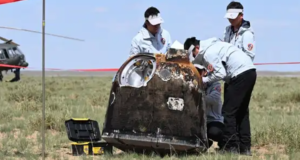Historic Achievement in Lunar Exploration
# This achievement follows India’s Chandrayaan-3 mission in August 2023, which successfully landed near the lunar South Pole region
 RNS: China achieved a significant milestone in space exploration on Tuesday by bringing back a capsule filled with lunar soil from the moon’s far side. This marks the latest success in China’s ambitious plans to explore the moon and other parts of the solar system.
RNS: China achieved a significant milestone in space exploration on Tuesday by bringing back a capsule filled with lunar soil from the moon’s far side. This marks the latest success in China’s ambitious plans to explore the moon and other parts of the solar system.
Mission Success
The Chang’e-6 lander, part of the China National Space Administration’s mission, retrieved the sample after a 53-day mission. The lunar probe module returned to Earth, successfully collecting the first-ever samples from the moon’s unexplored far side, a major advancement for China’s space program.
Precise Landing
The return capsule landed precisely at 2:07 pm (Beijing Time) in the designated area in Siziwang Banner, located in north China’s Inner Mongolia Autonomous Region. The China National Space Administration (CNSA) declared the mission a complete success.
Scientific Significance
“Chang’e-6 is the first mission in human history to return samples from the far side of the moon,” said Long Xiao, a planetary geologist at China University of Geosciences. He described it as a major event for scientists worldwide and a cause for celebration for all humanity.
International Implications
This achievement has sparked hopes for international lunar sample exchanges, highlighting the potential for China’s robotic missions to the moon and Mars to advance scientific understanding of the solar system. However, some view this milestone as part of a 21st-century space race with geopolitical implications.
Pioneering Exploration
Notably, China’s probe is the first to reach and collect samples from the moon’s far side. This follows India’s success in August 2023 when its Chandrayaan-3 mission became the first to land near the lunar South Pole region.
Technical Challenges
China had previously landed on the far side of the moon in 2019. The far side, which faces away from Earth, poses technical challenges due to its distance, giant craters, and few flat surfaces.
Sample Analysis
The reentry module will be airlifted to Beijing, where the lunar samples will be transferred to a team of scientists for storage, analysis, and study, according to the CNSA. The Chang’e-6 probe is expected to have returned with up to 2 kilograms of moon dust and rocks from the lunar far side, which will be analyzed by Chinese researchers before being opened to international scientists.
Mission Details
The Chang’e lunar exploration probe is named after the Chinese mythical moon goddess. Launched on May 3, the Chang’e-6 mission consists of an orbiter, a returner, a lander, and an ascender. Supported by the Queqiao-2 relay satellite, the lander-ascender combination landed in the South Pole-Aitken Basin on the moon’s far side on June 2 and carried out sampling work. The ascender took off from the moon on June 4 with samples and completed rendezvous and docking with the orbiter-returner combination on June 6, transferring the samples to the returner.
Lunar Orbit and Return
The orbiter-returner combination spent 13 days in lunar orbit, awaiting the right opportunity to return to Earth.
Future Prospects
“The Chang’e-6 mission represents a significant milestone in the history of human lunar exploration and will contribute to a more comprehensive understanding of lunar evolution,” said Yang Wei, a researcher at the Institute of Geology and Geophysics of the Chinese Academy of Sciences. He added that new samples will inevitably lead to new discoveries. The fascination with the moon is deeply rooted in Chinese culture, symbolized by the myth of Chang’e, a lady who journeyed to and resided on the moon. Now, Chinese scientists eagerly anticipate contributing to lunar science, Yang told Xinhua.



